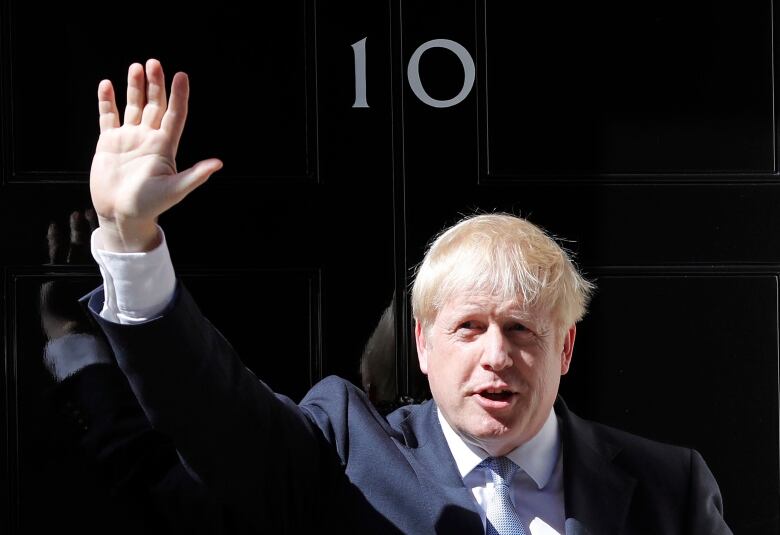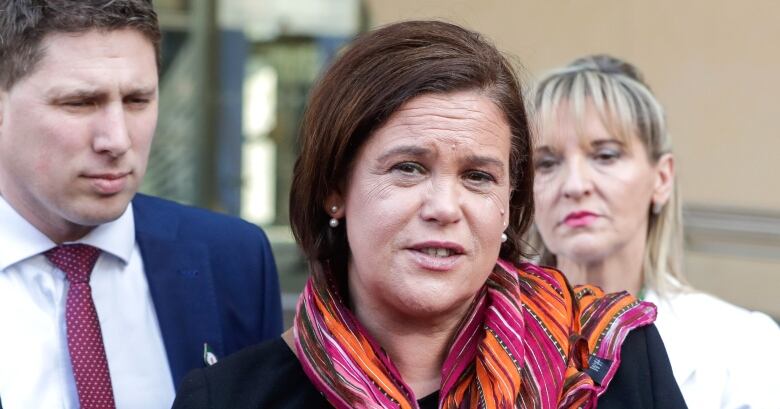The Republic of Ireland and Northern Ireland have been divided by a largely invisible border since 1998. But Brexit has sparked anxiety that the border could once again become very visible — and a cause of conflict and violence. Ideas host Nahlah Ayed went there to hear what people are saying.

Listen to the full episode53:59
By Nahlah Ayed and Philip Coulter
Far from the rancorous debates in London, at the most contentious border in the European Union, Garrett Carr went on an epic trek in pursuit of an “optimistic” mission.
The author’s plan was to map Ireland’s much-maligned border that’s been largely invisible and quiet for years thanks to a peace deal reached on Good Friday in 1998. Along the way, he was surprised to find incredible beauty, or what he calls a “slow, peaceful rural environment.”
What he also came away with was a map of the border’s violent history — and a sense of the anxiety that besets the people who live there.
“You’re looking at very innocent, bucolic picturesque sort of scenes. But you know that [nearby] two people are shot. Over there, a farmer was shot. Over there, an army convoy was ambushed. And so you’re kind of aware of the blood on the ground as well.”
Brexit anxiety
That violent legacy is at the root of today’s Brexit anxiety here.
Unlike the Republic of Ireland, Northern Ireland is part of the U.K., and would ultimately leave the European Union if Brexit happens.
From the start, Brexit concerns here have focused on the future of the now-invisible Irish border dividing north and south, and the fear that the border could re-materialize into a three-dimensional, hard border with customs or immigration checks — possibly reigniting its violent past.
Brexit is a constitutional earthquake for us.– Mary Lou McDonald, president of Sinn Fein, nationalist Irish party
Many believe such infrastructure would invite attacks from Irish nationalists who have never accepted the border.
Carr doesn’t believe that will happen.
However, he did find ample concern along the border, particularly acute among the older generations, who have the memories and the experience to immediately envisage the pitfalls of such a rupture.

They had lived through The Troubles, the violent conflict that started in the 1960s and lasted decades, pitting nationalist Catholics against pro-British Protestants.
“You hear a lot of anxiety from them,” said Carr, who walked the entire 500-kilometre line that could soon become the EU’s westernmost border. His book, The Rule of the Land, chronicles his journey.
“They can remember how things were before and they can remember how quickly things can sort of unravel and how quickly things can sort of start to go wrong.”
We know from history it doesn’t take large numbers to bring serious disruption and to … wreak havoc.– Diarmaid Ferriter, Irish historian
Three years after Britain voted in a referendum to leave the EU, the exact effect of such a move for the Irish border is still unknown.
The deal currently on the table with the EU includes guarantees of no hard border. But with the U.K. government insisting the deal be amended, there is no assurance that it will be implemented if Brexit goes ahead as scheduled on Oct. 31.

U.K. Prime Minister Boris Johnson continues to insist upon keeping a no-deal Brexit on the table as an option, despite parliamentary attempts to rule it out.
Like the rest of the U.K. and Europe, the island of Ireland could sustain sizable economic injury if a no-deal Brexit goes ahead. Without negotiated rules, it could choke the free movement of people and goods.
But because of the possible implications for their shared border, some in Northern Ireland and the Republic of Ireland see the potential impact as transformational — and not in a good way.
The Irish border was drawn in 1921 to partition Ireland into a newly independent Irish state in the south, and Northern Ireland, where a hard core of English settlers had taken up arms to remain a part of Britain.
For most of the next 80 years, the Irish border was the cause of bloody conflict.
“You would like to think that the era of intense violence as a result of a divided island on the border question is gone. But the reality is a hard border now — and has always — attracted violence,” said Irish historian Diarmaid Ferriter.
“We know from history it doesn’t take large numbers to bring serious disruption and to … wreak havoc.”
A ‘maligned’ invisible border
The border was based on old county lines from the 16th century, which meant it zigzagged across roads and split communities. For many who believe in a united Ireland, it was, and continues to be, an abomination.
The 1998 Good Friday Agreement formally ended the fighting — and with it, the military and customs checks at the border were also eliminated.
Despite the relative peace and invisibility the border has since enjoyed, it is still “the most maligned place,” says Carr. That’s what drew him to explore it. In crossing fields, bogs and lakes, he quickly discovered just how erratic the line is.

“That is actually a pretty random line, really, that was never meant to do such a job,” he told CBC’s Ideas.
In some places, he says, “it goes down the middle of streets and villages, it even divides some buildings. In fact, sometimes you sort of had trouble pinning down exactly where it was.”
In Northern Ireland, its presence is again keenly felt — for the first time in more than 20 years.
“A border that was for all practical purposes melting away has now come front and centre into a European-wide controversy,” said Colin Harvey, a professor of human rights law at Queen’s University in Belfast.
“For many people in border areas who have lived through the conflict, it’s been a process of re-traumatization.”
Political shift
Beyond the trauma of the violence, which killed more than 3,600 people during The Troubles, for many Catholics in Northern Ireland, the border also conjures up the sense of being left behind.
“The community that I grew up in essentially felt the border became a marker of abandonment,” said Harvey, who is from the city known as Derry to Irish nationalists, and Londonderry to pro-British Protestants.
The drawn-out Brexit chaos in Westminster has also been shifting the political ground here.
Brexit detractors say it has sparked new instability. They blame it as one of the catalysts for the occasional bursts of sectarian violence in Northern Ireland. They say it has put new pressure on the peace agreement that has largely stemmed the violence here for two decades.
Northern Ireland has also been contending with an impasse that has left its power-sharing Parliament, run by nationalists and loyalists, suspended since January 2017. Critics say the Brexit uncertainty has exacerbated the stalemate and sharpened sectarian tension.

It has also caused anxiety about upholding the Good Friday Agreement. The uncertainty has helped a violent minority opposed to the deal from the start to recruit.
“Brexit is a constitutional earthquake for us,” said Mary Lou McDonald, the president of Sinn Fein, a staunchly nationalist Irish party that has representatives on both sides of the border.
“It pulls the rug from under all of the assumptions that marked and made possible the Good Friday Agreement.”
But the Brexit uncertainty has also started a novel conversation about the prospect of Irish reunification between north and south.
“This has become a very central discussion,” said Harvey, the human rights professor in Belfast.
The Republic of Ireland “may look like the better option” for young people in Northern Ireland because it will continue to be part of the European Union, he said.
Historian Diarmaid Ferriter agrees the conversation has shifted beyond the traditional fault lines.
“There are civic Unionists who are coming together as well, to try and take the emotion out of this question, and think practically about what might be involved in a new Ireland, or a shared Ireland, or an agreed Ireland,” he said.
“You don’t have to abandon your own culture — there’s no reason they can’t co-exist.”
